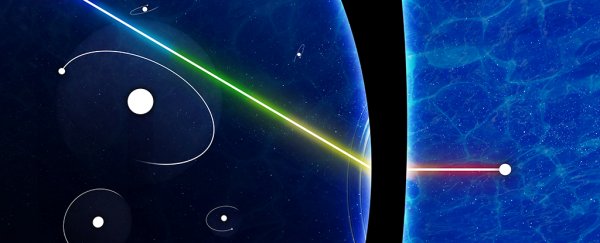In quantum physics, particles can 'tunnel' through seemingly impenetrable barriers, even when they apparently don't have the energy to do so. Now, researchers have gleaned behind the curtain to better understand how this trick is done.
This problem has puzzled scientists for decades – in particular, the time it takes for particles to do their quantum tunnelling, and get from one side of a barrier to another.
In the case of the atomic hydrogen particles used in these experiments, the researchers found that it happens instantaneously.
That instant transmission had been investigated before, but now scientists have observed it in the lab by using a special piece of equipment called an attoclock: a device that uses the properties of light to measure particle progress.
"We use the simplest atom, atomic hydrogen, and we've found that there's no delay in what we can measure," says one of the team, Robert Sang from Griffith University in Australia.
The attoclock setup used 1,000 ultra-short pulses of light per second to interact with hydrogen atoms, pulses totalling 30 gigawatts of instantaneous power. That created the conditions where the single electron of the atoms could be pushed through a barrier.
By using hydrogen atoms, with their simple atomic structure, the team was able to eliminate the approximations that had been factored into previous experiments on quantum particle tunnelling.
"There's a well-defined point where we can start that interaction, and there's a point where we know where that electron should come out if it's instantaneous," says Sang. "So anything that varies from that time we know that it's taken that long to go through the barrier. That's how we can measure how long it takes."
"It came out to agree with the theory within experimental uncertainty being consistent with instantaneous tunnelling."
It's another one of the mysteries of quantum mechanics that scientists now have a better handle on, making progress on a thorny problem physicists have grappled with since the 1930s.
The new knowledge gleaned from these attoclock experiments – which ran over three years – could be useful everywhere where quantum tunnelling happens, including electron microscopes and the transistors inside our computers.
Quantum tunnelling has also been suggested as a way of harvesting energy from excess radiation and waste heat, so the more we understand about the way the process actually works, the better.
In the meantime, the new research can be used as a basis for studying how other kinds of atoms tunnel through barriers and at what speeds – and that could potentially lead to a whole host of new discoveries about the phenomenon.
"Now that we've tested this atom, we can benchmark this process with other atoms to possibly learn new physics," says one of the researchers, Igor Litvinyuk from Griffith University. "We know that the test atom gives us zero delay, so all other delays can be calibrated in respect to that."
The research has been published in Nature.
